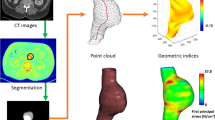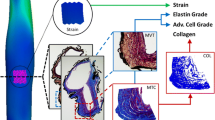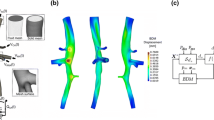Abstract
Background
Mouse models of abdominal aortic aneurysm (AAA) and dissection have proven to be invaluable in the advancement of diagnostics and therapeutics by providing a platform to decipher response variables that are elusive in human populations. One such model involves systemic Angiotensin II (Ang-II) infusion into low density-lipoprotein receptor-deficient (LDLr−/−) mice leading to intramural thrombus formation, inflammation, matrix degradation, dilation, and dissection. Despite its effectiveness, considerable experimental variability has been observed in AAAs taken from our Ang-II infused LDLr−/− mice (n = 12) with obvious dissection occurring in 3 samples, outer bulge radii ranging from 0.73 to 2.12 mm, burst pressures ranging from 155 to 540 mmHg, and rupture location occurring 0.05 to 2.53 mm from the peak bulge location.
Objective
We hypothesized that surface curvature, a fundamental measure of shape, could serve as a useful predictor of AAA failure at supra-physiological inflation pressures.
Methods
To test this hypothesis, we fit well-known biquadratic surface patches to 360o micro-mechanical test data and used Spearman’s rank correlation (rho) to identify relationships between failure metrics and curvature indices.
Results
We found the strongest associations between burst pressure and the maximum value of the first principal curvature (rho = −0.591, p-val = 0.061), the maximum value of Mean curvature (rho = −0.545, p-val = 0.087), and local values of Mean curvature at the burst location (rho = −0.864, p-val = 0.001) with only the latter significant after Bonferroni correction. Additionally, the surface profile at failure was predominantly convex and hyperbolic (saddle-shaped) as indicated by a negative sign in the Gaussian curvature. Findings reiterate the importance of shape in experimental models of AAA.











Similar content being viewed by others
References
Weiford BC (2005) Braunwald’s heart disease: a textbook of cardiovascular medicine. JAMA J Am Med Assoc 294:376–376
Elefteriades JA, Olin JW, Halperin JL (2011) Chapter 106. Diseases of the aorta. In: Fuster V, Walsh RA, Harrington RA (eds) Hurst’s the heart, 13th edn. The McGraw-Hill Companies, New York
Mamkin I, Heitner JF (2011) Chapter 22. Diseases of the aorta. In: Pahlm O, Wagner GS (eds) Multimodal cardiovascular imaging: principles and clinical applications. The McGraw-Hill Companies, New York
Vorp DA (2007) Biomechanics of abdominal aortic aneurysm. J Biomech 40:1887–1902. https://doi.org/10.1016/j.jbiomech.2006.09.003
Sacks MS, Vorp D a, Raghavan ML, et al (1999) In vivo three-dimensional surface geometry of abdominal aortic aneurysms. Ann Biomed Eng 27:469–479
Nordon IM, Hinchliffe RJ, Loftus IM, Thompson MM (2011) Pathophysiology and epidemiology of abdominal aortic aneurysms. Nat Rev Cardiol 8:92–102. https://doi.org/10.1038/nrcardio.2010.180
Kent KC, Zwolak RM, Jaff MR, Hollenbeck ST, Thompson RW, Schermerhorn ML, Sicard GA, Riles TS, Cronenwett JL, Society for Vascular Surgery, American Association of Vascular Surgery, Society for Vascular Medicine and Biology (2004) Screening for abdominal aortic aneurysm: a consensus statement. J Vasc Surg 39:267–269. https://doi.org/10.1016/j.jvs.2003.08.019
Timaran CH, Veith FJ, Rosero EB, Modrall JG, Arko FR, Clagett GP, Valentine RJ (2007) Endovascular aortic aneurysm repair in patients with the highest risk and in-hospital mortality in the United States. Arch Surg 142:520–524; discussion 524-5. https://doi.org/10.1001/archsurg.142.6.520
Brady AR, Brown LC, Fowkes FGR et al (2002) Long-term outcomes of immediate repair compared with surveillance of small abdominal aortic aneurysms. N Engl J Med 346:1445–1452. https://doi.org/10.1056/NEJMoa013527
Koskas F, Kieffer E (1997) Long-term survival after elective repair of infrarenal abdominal aortic aneurysm: results of a prospective multicentric study. Ann Vasc Surg 11:473–481
Lund GB, Trerotola SO, Scheel PJ (1995) Percutaneous translumbar inferior vena cava cannulation for hemodialysis. Am J Kidney Dis 25:732–737. https://doi.org/10.1016/0272-6386(95)90549-9
Dobrin PB (1989) Pathophysiology and pathogenesis of aortic aneurysms. Current concepts. Surg Clin North Am 69:687–703
Lee K, Zhu J, Shum J, Zhang Y, Muluk SC, Chandra A, Eskandari MK, Finol EA (2013) Surface curvature as a classifier of abdominal aortic aneurysms: a comparative analysis. Ann Biomed Eng 41:562–576. https://doi.org/10.1007/s10439-012-0691-4
Urrutia J, Roy A, Raut SS, Antón R, Muluk SC, Finol EA (2018) Geometric surrogates of abdominal aortic aneurysm wall mechanics. Med Eng Phys 59:43–49. https://doi.org/10.1016/j.medengphy.2018.06.007
Martufi G, Gasser TC, Appoo JJ, Di Martino ES (2014) Mechano-biology in the thoracic aortic aneurysm: a review and case study. Biomech Model Mechanobiol 13:917–928. https://doi.org/10.1007/s10237-014-0557-9
Gray A (1998) Modern differential geometry of curves and surfaces with Mathematica, 2nd edn. CRC Press, Boca Raton
Elger DF, Blackketter DM, Budwig RS, Johansen KH (1996) The influence of shape on the stresses in model abdominal aortic aneurysms. J Biomech Eng 118:326–332. https://doi.org/10.1115/1.2796014
Humphrey JD (2002) Cardiovascular solid mechanics: cells, tissues, and organs. Springer, New York
Martufi G, Di Martino ES, Amon CH et al (2009) Three-dimensional geometrical characterization of abdominal aortic aneurysms: image-based wall thickness distribution. J Biomech Eng 131:1–11. https://doi.org/10.1115/1.3127256
Shum J, Martufi G, Di Martino E et al (2011) Quantitative assessment of abdominal aortic aneurysm geometry. Ann Biomed Eng 39:277–286. https://doi.org/10.1007/s10439-010-0175-3
Goergen CJ, Barr KN, Huynh DT, Eastham-Anderson JR, Choi G, Hedehus M, Dalman RL, Connolly AJ, Taylor CA, Tsao PS, Greve JM (2010) In vivo quantification of murine aortic cyclic strain, motion, and curvature: implications for abdominal aortic aneurysm growth. J Magn Reson Imaging 32:847–858. https://doi.org/10.1002/jmri.22331
Daugherty A, Cassis LA (2004) Mouse models of abdominal aortic aneurysms. Arterioscler Thromb Vasc Biol 24:429–434. https://doi.org/10.1161/01.ATV.0000118013.72016.ea
Lane BA, Wang X, Lessner SM, Vyavahare NR, Eberth JF (2020) Targeted gold nanoparticles as an Indicator of mechanical damage in an Elastase model of aortic aneurysm. Ann Biomed Eng 48:2268–2278. https://doi.org/10.1007/s10439-020-02500-5
Daugherty A, Manning MWW, Cassis LAA (2000) Angiotensin II promotes atherosclerotic lesions and aneurysms in apolipoprotein E-deficient mice. J Clin Invest 105:1605–1612. https://doi.org/10.1172/JCI7818
Liu J, Sawada H, Howatt DA et al (2020) Hypercholesterolemia accelerates both the initiation and progression of angiotensin II-induced abdominal aortic aneurysms. Ann Vasc Med Res 6:1099
Cassis LA, Gupte M, Thayer S, Zhang X, Charnigo R, Howatt DA, Rateri DL, Daugherty A (2009) ANG II infusion promotes abdominal aortic aneurysms independent of increased blood pressure in hypercholesterolemic mice. Am J Physiol Circ Physiol 296:H1660–H1665. https://doi.org/10.1152/ajpheart.00028.2009
Phillips EH, Yrineo AA, Schroeder HD, Wilson KE, Cheng JX, Goergen CJ (2015, 2015) Morphological and biomechanical differences in the elastase and AngII apoE −/− rodent models of abdominal aortic aneurysms. Biomed Res Int 2015:–12. https://doi.org/10.1155/2015/413189
Bersi MR, Acosta Santamaría VA, Marback K, di Achille P, Phillips EH, Goergen CJ, Humphrey JD, Avril S (2020) Multimodality imaging-based characterization of regional material properties in a murine model of aortic dissection. Sci Rep 10:9244. https://doi.org/10.1038/s41598-020-65624-7
Saraff K, Babamusta F, Cassis LA, Daugherty A (2003) Aortic dissection precedes formation of aneurysms and atherosclerosis in angiotensin II-infused, apolipoprotein E-deficient mice. Arterioscler Thromb Vasc Biol 23:1621–1626. https://doi.org/10.1161/01.ATV.0000085631.76095.64
Phillips EH, Lorch AH, Durkes AC, Goergen CJ (2018) Early pathological characterization of murine dissecting abdominal aortic aneurysms. APL Bioeng 2:046106. https://doi.org/10.1063/1.5053708
Adelsperger AR, Phillips EH, Ibriga HS et al (2018) Development and growth trends in angiotensin II-induced murine dissecting abdominal aortic aneurysms. Physiol Rep 6:1–17. https://doi.org/10.14814/phy2.13668
Sacks MS, Chuong CJ, Templeton GH, Peshock R (1993) In vivo 3-D reconstruction and geometric characterization of the right ventricular free wall. Ann Biomed Eng 21:263–275
Wang X, Lane BA, Eberth JF, Lessner SM, Vyavahare NR (2019) Gold nanoparticles that target degraded elastin improve imaging and rupture prediction in an AngII mediated mouse model of abdominal aortic aneurysm. Theranostics 9:4156–4167. https://doi.org/10.7150/thno.34441
Lane BA, Lessner SM, Vyavahare NR, Sutton MA, Eberth JF (2020) Null strain analysis of submerged aneurysm analogues using a novel 3D stereomicroscopy device. Comput Methods Biomech Biomed Engin 23:332–344. https://doi.org/10.1080/10255842.2020.1724974
Vorp DA, Raghavan ML, Webster MW (1998) Mechanical wall stress in abdominal aortic aneurysm: influence of diameter and asymmetry. J Vasc Surg 27:632–639
Chauhan SS, Gutierrez CA, Thirugnanasambandam M, de Oliveira V, Muluk SC, Eskandari MK, Finol EA (2017) The association between geometry and wall stress in emergently repaired abdominal aortic aneurysms. Ann Biomed Eng 45:1908–1916
Yamada H, Hasegawa Y (2007) A simple method of estimating the stress acting on a bilaterally symmetric abdominal aortic aneurysm. Comput Methods Biomech Biomed Engin 10:53–61. https://doi.org/10.1080/10255840601086531
Azar D, Ohadi D, Rachev A, Eberth JF, Uline MJ, Shazly T (2018) Mechanical and geometrical determinants of wall stress in abdominal aortic aneurysms: a computational study. PLoS One 13:e0192032. https://doi.org/10.1371/journal.pone.0192032
Collins MJ, Eberth JF, Wilson E, Humphrey JD (2012) Acute mechanical effects of elastase on the infrarenal mouse aorta: implications for models of aneurysms. J Biomech 45:660–665. https://doi.org/10.1016/j.jbiomech.2011.12.013
Aslanidou L, Ferraro M, Lovric G, Bersi MR, Humphrey JD, Segers P, Trachet B, Stergiopulos N (2019) Co-localization of microstructural damage and excessive mechanical strain at aortic branches in angiotensin-II-infused mice. Biomech Model Mechanobiol 19:81–97. https://doi.org/10.1007/s10237-019-01197-3
Vorp DA, Vande Geest JP (2005) Biomechanical determinants of abdominal aortic aneurysm rupture. Arterioscler Thromb Vasc Biol 25:1558–1566. https://doi.org/10.1161/01.ATV.0000174129.77391.55
Di Martino E, Mantero S, Inzoli F et al (1998) Biomechanics of abdominal aortic aneurysm in the presence of endoluminal thrombus: experimental characterisation and structural static computational analysis. Eur J Vasc Endovasc Surg 15:290–299
Parikh SA, Gomez R, Thirugnanasambandam M, Chauhan SS, de Oliveira V, Muluk SC, Eskandari MK, Finol EA (2018) Decision tree based classification of abdominal aortic aneurysms using geometry quantification measures. Ann Biomed Eng 46:2135–2147
Wu W, Rengarajan B, Thirugnanasambandam M, Parikh S, Gomez R, de Oliveira V, Muluk SC, Finol EA (2019) Wall stress and geometry measures in electively repaired abdominal aortic aneurysms. Ann Biomed Eng 47:1611–1625
Rengarajan B, Wu W, Wiedner C et al (2020) A comparative classification analysis of abdominal aortic aneurysms by machine learning algorithms. Ann Biomed Eng 1–11
Goergen CJ, Azuma J, Barr KN, Magdefessel L, Kallop DY, Gogineni A, Grewall A, Weimer RM, Connolly AJ, Dalman RL, Taylor CA, Tsao PS, Greve JM (2011) Influences of aortic motion and curvature on vessel expansion in murine experimental aneurysms. Arterioscler Thromb Vasc Biol 31:270–279. https://doi.org/10.1161/ATVBAHA.110.216481
Collins MJ, Bersi M, Wilson E, Humphrey JD (2011) Mechanical properties of suprarenal and infrarenal abdominal aorta: implications for mouse models of aneurysms. Med Eng Phys 33:1262–1269. https://doi.org/10.1016/j.medengphy.2011.06.003
Prim DA, Mohamed MA, Lane BA, Poblete K, Wierzbicki MA, Lessner SM, Shazly T, Eberth JF (2018) Comparative mechanics of diverse mammalian carotid arteries. PLoS One 13:e0202123
Cox RH (1978) Passive mechanics and connective tissue composition of canine arteries. Am J Phys 234:H533–H541
Goergen CJ, Johnson BL, Greve JM, Taylor CA, Zarins CK (2007) Increased anterior abdominal aortic wall motion: possible role in aneurysm pathogenesis and design of endovascular devices. J Endovasc Ther 14:574–584. https://doi.org/10.1583/1545-1550(2007)14[574:IAAAWM]2.0.CO;2
Zhou B, Alshareef M, Prim DA, Collins M, Kempner M, Hartstone-Rose A, Eberth JF, Rachev A, Shazly T (2016) The perivascular environment along the vertebral artery governs segment-specific structural and mechanical properties. Acta Biomater 45:286–295. https://doi.org/10.1016/j.actbio.2016.09.004
Watson S, Liu P, Peña EA et al (2016) Comparison of aortic collagen Fiber angle distribution in mouse models of atherosclerosis using second-harmonic generation (SHG) microscopy. Microsc Microanal 22:55–62. https://doi.org/10.1017/S1431927615015585
Zhou B, Prim DA, Romito EJ, McNamara LP, Spinale FG, Shazly T, Eberth JF (2018) Contractile smooth muscle and active stress generation in porcine common carotids. J Biomech Eng 140:014501. https://doi.org/10.1115/1.4037949
Genovese K, Collins M, Lee Y, Humphrey JD (2012) Regional finite strains in an angiotensin-II induced mouse model of dissecting abdominal aortic aneurysms. Cardiovasc Eng Technol 3:194–202
Bersi MR, Bellini C, Di Achille P et al (2016) Novel methodology for characterizing regional variations in the material properties of murine aortas. J Biomech Eng 138:71005–71015
Smith DB, Sacks MS, Vorp DA, Thornton M (2000) Surface geometric analysis of anatomic structures using biquintic finite element interpolation. Ann Biomed Eng 28:598–611. https://doi.org/10.1114/1.1306342
Acknowledgments
The authors would like to acknowledge the statistical guidance provided by Dr. Jan M. Eberth, the conceptual contributions of Dr. Susan M. Lessner, and the technical assistance of Liya Du to this project.
Funding
This work was supported by the National Institutes of Health under grant number R01HL133662.
Author information
Authors and Affiliations
Corresponding author
Ethics declarations
Conflict of Interest
The authors have no competing conflicts of interest that could have influenced the findings of this paper. All animal procedures were approved by the Clemson University Institutional Animal Care and Use Committee (IACUC).
Additional information
Publisher’s Note
Springer Nature remains neutral with regard to jurisdictional claims in published maps and institutional affiliations.
Rights and permissions
About this article
Cite this article
Lane, B., Uline, M., Wang, X. et al. The Association Between Curvature and Rupture in a Murine Model of Abdominal Aortic Aneurysm and Dissection. Exp Mech 61, 203–216 (2021). https://doi.org/10.1007/s11340-020-00661-x
Received:
Accepted:
Published:
Issue Date:
DOI: https://doi.org/10.1007/s11340-020-00661-x




